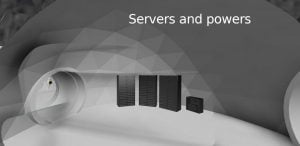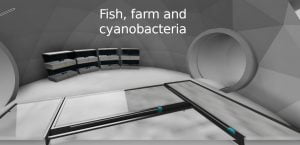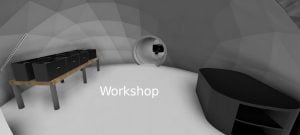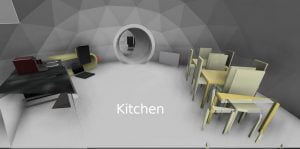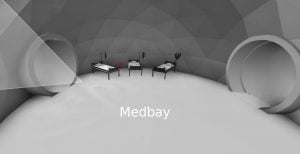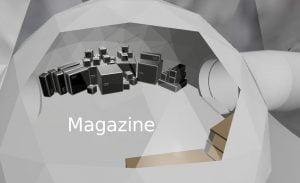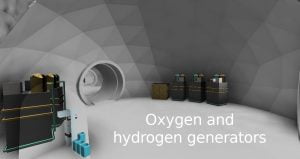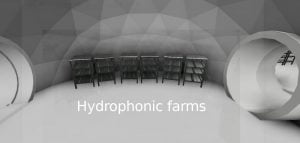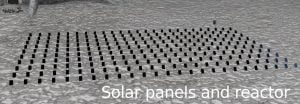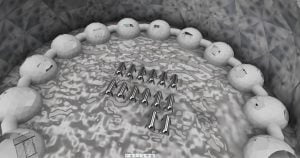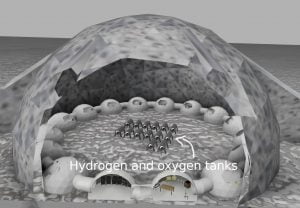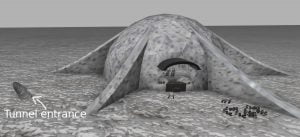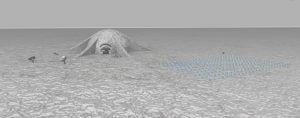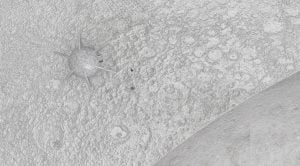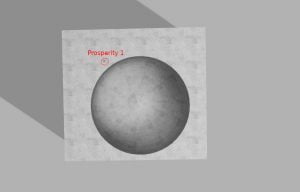Moon Camp Pioneers Gallery 2020-2021
In Moon Camp Pioneers each team’s mission is to 3D design a complete Moon Camp using Fusion 360. They also have to explain how they will use local resources, protect astronauts from the dangerous of space and describe the living and working facilities.
Team: ALOPWR
Akademickie Liceum Ogólnokształcące Politechniki Wrocławskiej Wrocław Poland 15
External viewer for 3d project
|
Project description
Prosperity 1 is an innovative and modern Moonbase. It’s designed to be the first base in a possible future colony. The whole project is friendly for long-standing stay on the Moon. It’s made of 16 main modules from which, each one has its’ purpose, those modules are connected by solid tubes. Examples of modules are magazine, living quarters, base administration, plants’ farm, med bay, bar, free time spending module workshop, laboratory, an oxygen and hydrogen distribution site, gym ,a fish farm and more. All modules are connected in the circle and hidden below the regolith dome which protects the base from radiation. Astronauts have big help from small multitasking robots which can do mining, farm caring, food preparing, magazine management and much more. Those robots will build the dome in the first phase. This is possible thanks to 3D printers which are used by robots to melt and distribute regolith. In the base, there are also metal dust 3D printers that are used to produce missing or additional parts. Next to the base, there’s solar panel farm and small, advanced nuclear reactor. There are also water electrolyzes which are adding essential minerals to melted ice so it’s drinkable for astronauts. Base has O2 and H2 generators, that use ice to produce oxygen and hydrogen. Astronauts have also their own rover. Prosperity 1 also uses Moxie system to convert carbon dioxide to oxygen and carbon, thanks to this oxygen becomes reusable and carbon can be used to produce CH4 as fuel.
|
|||
|
Where do you want to build your Moon Camp?
Prosperity 1 will be on the south pole of the Moon, over a huge, always dark crater. Thanks to this property there’s ice in the crater and it can be mined. Astronauts can send robots or go there by themselves. The tunnel mined by robots will allow them to reach lower parts of the crater and to mine there. The tunnel looks really long but its’ middle part is previously selected lava tube, so robots don’t have to mine for a long time. This location also allows the whole colony to be located all around the crater. If the colony was advanced, settlers would mine goods like lithium, iron and other ores from crater.
How do you plan to build your Moon Camp? Describe the techniques and materials you would use.
The base building is divided into three phases. In phase one, group of two hundred arrives. Robots have 50 solar panels and necessary components to start mining regolith and distribute it. It’s all needed to build regolith shelter which will protect astronauts from radiation. Robots have AI which allows them to communicate within group, plan and build regolith dome and then do their other tasks. Together with the robots spare parts such as batteries, mining tools, storages, dippers, robotic arms and 3D printing system arrive on Moon. They can be attached to robots magnetically, robots also can connect to each other and cooperate. Robot have to mine tunnel into crater to find ice. Then the robots have one more task which is to build module from transported accessories for astronauts to live while building base. In phase two the first astronauts arrive. At the beginning they live in module built by robots. During that phase they start to part 16 inflatable modules inside regolith dome. Astronauts also bring 150 solar panels, equipment for modules, small and modern nuclear reactor and supplies needed for the first months. In part three, pack of decorative plants, advanced hydroponic installation, metal dust 3D printers and rover arrives. Metal dust 3D printers can be used to print additional or missing parts for base, rovers and robots. After phase three base is ready for astronauts’ usage, also it’s not point where robots mission ends, they help astronauts with ice mining, plant caring, food preparation and more.
The environment on the Moon is very dangerous for the astronauts. Explain how your Moon Camp will protect them.
A huge regolith dome can protect astronauts from radiation by absorbing it. The dome is 2 meters thick which is great to absorb radiation and be buildable for [will be built by?] robots. Properly built dome can survive the impact of cosmic debris and can be quickly rebuilt by robots. It can also survive meteor stroke. The oxygen is sourced from O2 and H2 generators which can obtain oxygen and hydrogen from ice. This provides oxygen to breathe for the crew and hydrogen to power rovers and heating plants in plant module. The oxygen constitutes about 30% of air in base 70% is nitrogen produced by cyanobacterias which produce nitrogen. Thanks to this, air in the base is similar to the Earth’s atmosphere. Energy and electricity in base is produced by solar panels, nuclear rector and bioenergy from food waste.
Explain how your Moon Camp will provide the astronauts with:
|
|||
|
Water
|
Food
|
Electricity
|
Air
|
|
Water is obtained from mined ice and is used to bath and wash some components. Drinkable water is obtained from ice too, but first it’s filtered, then electrolyted and mineralized by devises. Minerals can be found in the Moon’s ores and then extracted from them by robots. Electrolytes can be made from beetroot’s juice. Later, water will be extracted from air. |
In hydroponic farms under robots and one botanic care plant will grow. There is going to be rice, beetroots, bell peppers, soya beans and Brussels sprouts, those plants provide all needed vitamins. According to NASA’s research fish grow, develop and act normally in space. That’s why near the plant module there is a special module with aquariums for fish which help astronauts’ circulatory system, sight, nervous system and muscles. |
Electricity and power is generated by 200 solar panels, small and modern nuclear reactor and bioenergy obtained from food waste. Heat is mostly generated by sun collectors and infrared generators. The first ones provide heat during Lunar day and the second ones do it during Lunar night. As infrared generators use big amounts of energy they’re supported by O2 and H2 generators which generate a lot of heat while disarticulating water. |
To make air in the base a breathable one we need about 30% of oxygen and 70% of nitrogen. Oxygen is obtained by O2 and H2 generators and is distributed by theirs cables located all around the base. Nitrogen is really hard to be found on the Moon. It can be imported from the Earth but that’s an easy way. Prosperity 1 base uses cyanobacterias to produce nitrogen. This organisms live in the base in special habitats, there they develop and produce nitrogen as their bodily functions. Then this nitrogen is filtered and distributed all around the base. |
|
Explain what would be the main purpose of your Moon Camp (for example: commercial, scientific, and/or tourist purposes).
The main purpose of Prosperity 1 is to allow people to stay on the Moon and to make research there. Well equipped laboratory helps astronauts and whole humanity to see how the Moon has evolved and how it works. Scientific development of humanity is one of the most important thing in the history and society. Prosperity 1 is also the first outpost of future human colony on Moon. Thanks to this, humanity will become interplanetary and we’ll be able to start Mars’ colonization. The colony of connected domes and plenty of modules under it humming with life.
|
|||
|
Describe a day on the Moon for your Moon Camp astronaut crew.
The whole astronaut crew in the base is built out of 12 members. In Prosperity 1 base, whole crew can sleep at the same time and live in normal 24 hour-day mode. It’s because robots will call astronauts if an emergency occurs. In the morning, the whole crew goes to a bar module to eat breakfast then they will proceed to do their jobs. The first task for engineers is to check all the equipment and the base to see if there aren’t any problems or poundings. If there’re any damages in the base, the crew can easily print out missing/damaged parts or equipment in metal dust 3D printers. Botanists’ task is to take care and observe plants at the beginning and then to set few robots to plant-caring mode. Then, a part of the crew goes to a laboratory or outside the base to get or study samples to get to know the Moon’s geological history, terraformation possibilities, how its’ properties affect living organisms and more. The rest part of the crew firstly checks modules like fish farms, energy, O2 and H2 generators to see if any resources are finishing or missing, if yes, a part of the crew goes to replenish and extract them. Two astronauts stay in a base management module to control base’s preservation and condition and also to check the contact with the Earth. All crew members outside the base need to be in constant contact with the base management module. Every two hours a botanist needs to check hydroponic system to check plants progress. After this reference he/she has to check with other crew member the fish’s condition and needs. IT specialist in the base has to regularly check condition and connection with robot horde. An important task for the crew is also to check industrial and exploitation possibilities on the Moon for future colonies. Those possibilities are mining resources, building bigger constructions and space engineering. During Lunar night activities performed by the crew are limited which means less frequent exiting outside and manned mining (mining is then done only by robots). Everyday some crew members need to check solar panels and reactor’s condition for the base safety. Secondary task for all the crew members is to prepare some things for the future, twin base and colony.
|
|||


